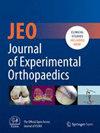Patients with borderline hip dysplasia present with inferior patient-reported outcomes compared to true hip dysplasia
Abstract
Purpose
The factors influencing patient-reported outcome measures (PROMs) in individuals with developmental dysplasia of the hip (DDH) remain poorly understood. The aim of this study was to determine the differences in hip-related PROMs in both borderline and true hip dysplasia.
Methods
A total of 245 patients with symptomatic DDH were enrolled. Hips were divided into either borderline dysplasia (lateral centre-edge angle [LCEA] 20°–25°) or true dysplasia (LCEA < 20°). PROMs were retrieved from all patients. Linear regression analysis was performed to identify potential factors associated with PROMs. The relationship between PROMs and the characteristic of dysplasia and between patients with DDH and healthy people was assessed.
Results
Patients with borderline hip dysplasia had significantly poorer scores compared to true dysplasia on the University of California and Los Angeles activity scale (UCLA), the Western Ontario and McMaster Universities Osteoarthritis Index (WOMAC), the Merle d'Aubigné and postel score and the German forgotten joint score (G-FJS). In patients with DDH, all PROMs were significantly lower compared to the control group. In patients with true dysplasia, body mass index (BMI) emerged as the most influential factor affecting the hip disability and osteoarthritis outcome score–physical function shortform (HOOS-PS), WOMAC, International Hip Outcome Tool 12 (iHOT-12) and Harris hip score (HHS). In contrast, in patients with borderline dysplasia, radiographic parameters such as anterior wall coverage significantly influenced the WOMAC, iHOT-12, HHS, modified HHS and G-FJS, while the LCEA was associated with UCLA and HOOS-PS scores. Age was identified as a significant predictor in borderline dysplasia.
Conclusion
Patients with borderline dysplasia report poorer PROMs compared to true dysplasia, suggesting a distinct clinical and diagnostic burden in this group of patients. Moreover, the increased mechanical load associated with higher BMI appears to play a greater role only in patients with true dysplasia.
Level of Evidence
Level III.





 求助内容:
求助内容: 应助结果提醒方式:
应助结果提醒方式:


